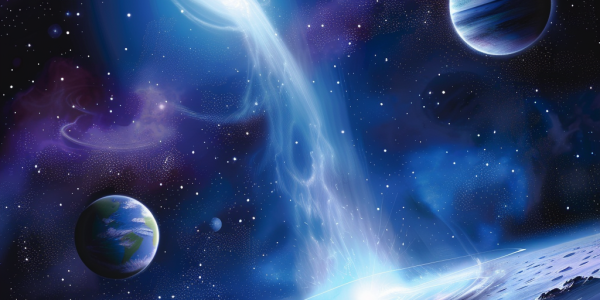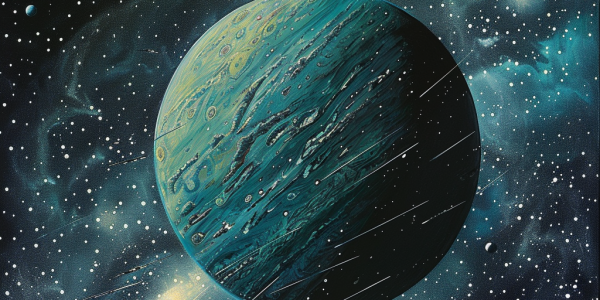Astrophysicists Discover Comet-Like Tail on Exoplanet WASP-69 b
Astrophysicists have discovered that the exoplanet WASP-69 b possesses a comet-like tail of gas extending 563,000 kilometers, revealing significant atmospheric loss due to photoevaporation. This hot Jupiter, located 160 light-years away, loses around 200,000 tons of gas per second, primarily hydrogen and helium, shaped by stellar winds. This groundbreaking research enhances our understanding of exoplanetary atmospheres and their dynamics, contributing to the field of astrophysics.
Research Suggests Potential for Life on White Dwarf Planets
Recent research suggests that planets orbiting white dwarfs, the remnants of stars that have exhausted their nuclear fuel, may be viable candidates for sustaining life. This study highlights the long lifespan and potential habitable zones around white dwarfs, which could provide stable environments for biological evolution. With the possibility of liquid water and geological activity, these celestial bodies challenge traditional astrobiology views and expand the search for extraterrestrial life.
NASA Integrates Key Instrument for Next-Gen Exoplanet Exploration
NASA’s integration of the Roman Coronagraph Instrument into the Nancy Grace Roman Space Telescope marks a pivotal advancement in exoplanet exploration. Set to launch in May 2027, this next-generation observatory will revolutionize our understanding of distant worlds, enabling the detection of light from planets 100 million times fainter than their stars. With a wide field of view and groundbreaking technology, the Roman Space Telescope is poised to unlock secrets of the universe and potentially identify Earth-like planets capable of supporting life.
Astronomers Reclassify HD 28185 c as Super-Jovian Planet
A recent study by astronomers from the University of Southern Queensland has reclassified HD 28185 c from a brown dwarf to a super-Jovian planet, revealing new insights into this celestial body. Published in the Monthly Notices of the Royal Astronomical Society, the research utilized 22 years of data to redefine the planet’s mass and orbital characteristics, highlighting the complexities of planetary systems and the importance of long-term observational studies in astronomy.
NASA’s Hubble and New Horizons Team Up to Capture Unprecedented Images of Uranus
NASA’s collaboration between the Hubble Space Telescope and New Horizons Pluto probe has resulted in groundbreaking images of Uranus, enhancing our understanding of the icy giant’s atmosphere and its implications for exoplanet exploration. This joint effort reveals intricate details and broader perspectives of Uranus, paving the way for future missions aimed at uncovering the mysteries of distant worlds.
The Sun’s Fate: Understanding Its Evolution and Impact on Earth
Astrophysicists discuss the Sun’s future and its impact on Earth, debunking myths about a supernova. Instead, the Sun will evolve into a red giant, altering conditions on Earth and ultimately leading to a white dwarf. Understanding this stellar evolution highlights the transient nature of existence and the delicate balance of life on our planet.
NASA Discovers Record-Setting Triple-Star System TIC 290061484
NASA’s Transiting Exoplanet Survey Satellite (TESS) has discovered TIC 290061484, a record-setting triple-star system in the Cygnus constellation, located 5,000 light-years from Earth. This unique system features the closest three-star arrangement ever observed, with two stars orbiting each other every 1.8 days and a third star completing its orbit every 25 days. The discovery highlights the significance of citizen scientists and promises to enhance our understanding of stellar formation and evolution.
Harnessing the Sun: A Revolutionary Concept for Cosmic Exploration
Scientists are exploring the revolutionary concept of transforming the Sun into a colossal telescope using gravitational lensing, potentially enhancing our ability to observe distant galaxies and celestial phenomena. This innovative approach could lead to groundbreaking discoveries in astronomy while offering a cost-effective alternative to traditional space telescopes. As researchers investigate the feasibility of this idea, the future of cosmic exploration looks promising.
NASA’s Habitable Worlds Observatory Aims to Uncover Inhabited Planets by 2050
NASA’s groundbreaking telescope, the Habitable Worlds Observatory (HWO), aims to uncover inhabited planets by 2050. Dr. Jessie Christiansen leads the charge in the search for extraterrestrial life, with 25 Earth-like planets already identified. With a $17.5 million investment, cutting-edge technologies will enhance the telescope’s capabilities, bringing us closer to unraveling the mysteries of the universe. ‘Super Hubble’ will enable direct imaging of Earth-size planets, analyzing their atmospheres for signs of life. Dr. Courtney Dressing envisions detecting various biosignatures, including technosignatures. Despite progress, the search for a rocky planet similar to Earth continues, but Dr. Christiansen remains hopeful for evidence of extraterrestrial life shortly after the telescope’s launch in 2040.
Fascinating Discoveries in Exoplanetary Weather
Explore the fascinating world of exoplanetary weather, from gas giants with high-speed winds to planets where it rains glass sideways. Discover the extreme conditions on distant worlds like WASP 43 b, Brown Dwarves with iron droplet clouds, and Hot Jupiter exoplanets leaking gaseous metals into space. Witness planet-spanning storms, gemstone rains, and diverse weather patterns that defy imagination. Astronomers continue to unveil the dynamic and varied weather conditions on exoplanets, expanding our understanding of the universe.










